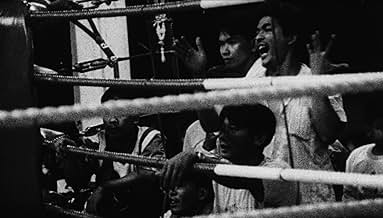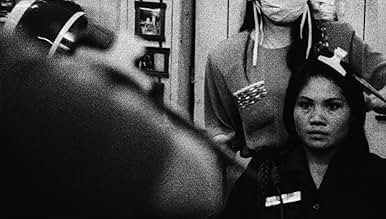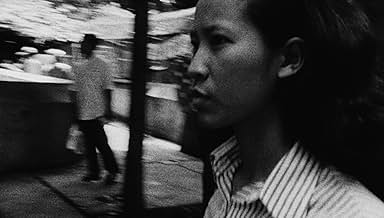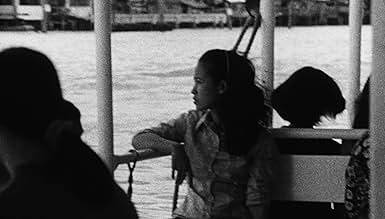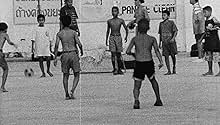NOTE IMDb
6,7/10
1,8 k
MA NOTE
Ajouter une intrigue dans votre langueA film crew documents a folk story-exquisite corpse combination by random Thai people; the story is reenacted.A film crew documents a folk story-exquisite corpse combination by random Thai people; the story is reenacted.A film crew documents a folk story-exquisite corpse combination by random Thai people; the story is reenacted.
- Réalisation
- Casting principal
- Récompenses
- 4 victoires et 4 nominations au total
Avis à la une
"Mysterious" held much dramatic promise.
But because of its hybrid innovation, I'm at a lost as to rate it as a dramatic feature or a documentary film. Either way, despite its critical accolades, it wasn't able to interest me enough to wanna cradle its inadequacies. Poor film making craft is inexcusable even if this feature is excusably in a league of its own. (And did anyone catch a moment of Ozu homage in one of the scenes, with children walking by at one end and the camera placed at another? Nice...)
That said, there were undeniable moments of brilliance in it. Two standouts come to mind; The "banter" between the two mute girls and that staged re-enactment by the villagers. And it shown the director to be one who knows how to capture such cinematic sparks, albeit inconsistently.
I thus hope to see "Blissfully yours" before I decide on my regard for Apichatpong Weerasethakul as a film maker. Similarly, "Mysterious" will be given the benefit of the doubt. For honestly, it just didn't hack it for me right now.
But because of its hybrid innovation, I'm at a lost as to rate it as a dramatic feature or a documentary film. Either way, despite its critical accolades, it wasn't able to interest me enough to wanna cradle its inadequacies. Poor film making craft is inexcusable even if this feature is excusably in a league of its own. (And did anyone catch a moment of Ozu homage in one of the scenes, with children walking by at one end and the camera placed at another? Nice...)
That said, there were undeniable moments of brilliance in it. Two standouts come to mind; The "banter" between the two mute girls and that staged re-enactment by the villagers. And it shown the director to be one who knows how to capture such cinematic sparks, albeit inconsistently.
I thus hope to see "Blissfully yours" before I decide on my regard for Apichatpong Weerasethakul as a film maker. Similarly, "Mysterious" will be given the benefit of the doubt. For honestly, it just didn't hack it for me right now.
i took my girlfriend to see this one after reading a very promising article about it in my monthly cinema newspaper. i regretted it after about 15 minutes of the movie. the main idea to it, to let a story develop by it's protagonists, thus making it a semi documentary, seems promising, but suffers under the usual problems movies have that relay on their actors as directors. they are non. so the movie is constantly on the verge of failure, while thru most parts being plain - i am sorry, but i have to use that word - boring. it is, as the short movies of weerasethakul, heavily based on long steady shots and seemingly unconnected pieces of sound and dialog. this may work as an installative work in an art context but definitely fails to deliver when watching it for about 90 minutes in a cinema. the only refreshing moments of the movie are the ones of self reference. one in which one assistant of the director appears, telling him that the whole thing does not work and that they better should have written a script, and one in which a kid actor is asking if he finally can go home (and if not, if afterwords he at least can get a burger at kfc :). i have to admit i really felt with the kid.
there's no real easy way to classify or summarize this movie. at its core there is a story that is developed by many (unrelated) people picking up where the last person left off...a creative game of sorts. the "story" of the film unfolds as villagers of different parts of thailand see fit (with the final cut going to the director, of course). we see not only the creators of the story developing the story that they did not begin, but also the story itself acted out by actors or village people, or sometimes not at all. it's a film experiment more than a film and should be approached as such. the last 15 minutes of the film is more of a documentary of thai people than about the story that has been evolving over the course of the film. it's an interesting view, but not great in any way. C+
(2000) Mysterious Object at Noon
DOCU DRAMA
Documented by Apichatpong Weerasethakul where he goes around uncovering a myth involving a student on a wheelchair and his teacher "Dogfahr". Filmed in black and white, sometimes the stories are made up while others are being told to and from other people throughout the entire city of Bangkok and Thailand. Viewers are left scratching their heads trying to figure what to make of it as a portion of the docudrama is sometimes off topic. We do not even get to see what is even written about the myth whether Dogfahr was actually dead or alive, or do we even get to visit the site that was supposed to have happened.
Documented by Apichatpong Weerasethakul where he goes around uncovering a myth involving a student on a wheelchair and his teacher "Dogfahr". Filmed in black and white, sometimes the stories are made up while others are being told to and from other people throughout the entire city of Bangkok and Thailand. Viewers are left scratching their heads trying to figure what to make of it as a portion of the docudrama is sometimes off topic. We do not even get to see what is even written about the myth whether Dogfahr was actually dead or alive, or do we even get to visit the site that was supposed to have happened.
An interesting film, more for the idea behind it and moments captured than the overall execution.
A filmmaker rolls around town in search of a story, making the film we see. It begins with long footage of driving around Bangkok, then we segue to the story proper with a woman being interviewed, asked about a story.
The story is made-up, the point is not the story of course, but dismantling the conventional telling. Different people are interviewed who bend the story to their fancy, adding stuff. We are not entirely sure who among them are actors coached on what to say, who are passers-by blurting out what comes in their heads. We can tell that some of it was obviously blocked to be filmed, some covertly staged as real and some stolen from glances but the whole is pretty seamless.
This is an opportunity to film all sorts of activities and splice it together to see what kind of sense comes out; among them an amateur theatric production of the story, a simulated TV interview filmed off the TV, (faux?) newsreel footage, real scenes of boxing, a singing contest and sex show, a scene from the film but the camera keeps rolling through the break. When the crippled boy is assigned a random background by one of the interviewees, in the following scene his teacher acquires the same background of war and family loss.
In the West, we have similar films of stories about stories in Saragossa Manuscript and such, where usually the point is structure, hidden meaning and the divination of self.
In the East, specifically Thailand, they have their own traditions of light storytelling and meta-narrative sorting of concepts, both defined by cultural proximity to India. Among the three 'holy' texts of their native Buddhism is a body of work called Abhidharma, teachings about the teachings. Composed after the Buddha's time, commentaries upon commentaries form a complex, layered web of cataloguing various ontological attributes of reality, phenomena and self. Boring if you ever try to read it.
On a historical note, there is evidence that abhidharmic influence in the north of India in turn rippled West through Persia to influence gnostic thought, and East through the Silk Road as both reaction to its scholasticism and elaboration of it contributed to early Chinese Buddhism. In both cases, the distinction is made between mere intellectual reasoning in the abhidharmic vein, and expansive meditative wisdom that looks directly at things. (respectively, gnosis and prajna)
Anyway, the film has no direct link to all that except as pointing to the mesh of meta-narrative.
And it's cool to note that springing from a Buddhist background, in this film of stories about stories the stories are transient, illusory confabulations, there's no intrinsic meaning or symbolism to them, there's no structure beyond co-dependent arising of narrator and image, and the narrator is neither a single self nor on some journey to enlightenment. Nice, if you don't burden yourself with futilely trying to organize the tangle, just directly look at the wondrous nothingness.
The last story is made-up by schoolchildren, collapsing in a fantastical, meaningless heap of witch tigers and magical swords, illusory child's play.
The closing shots are of children kicking a ball, the rush of actual life outside the stories which is the most mysterious object of all.
A filmmaker rolls around town in search of a story, making the film we see. It begins with long footage of driving around Bangkok, then we segue to the story proper with a woman being interviewed, asked about a story.
The story is made-up, the point is not the story of course, but dismantling the conventional telling. Different people are interviewed who bend the story to their fancy, adding stuff. We are not entirely sure who among them are actors coached on what to say, who are passers-by blurting out what comes in their heads. We can tell that some of it was obviously blocked to be filmed, some covertly staged as real and some stolen from glances but the whole is pretty seamless.
This is an opportunity to film all sorts of activities and splice it together to see what kind of sense comes out; among them an amateur theatric production of the story, a simulated TV interview filmed off the TV, (faux?) newsreel footage, real scenes of boxing, a singing contest and sex show, a scene from the film but the camera keeps rolling through the break. When the crippled boy is assigned a random background by one of the interviewees, in the following scene his teacher acquires the same background of war and family loss.
In the West, we have similar films of stories about stories in Saragossa Manuscript and such, where usually the point is structure, hidden meaning and the divination of self.
In the East, specifically Thailand, they have their own traditions of light storytelling and meta-narrative sorting of concepts, both defined by cultural proximity to India. Among the three 'holy' texts of their native Buddhism is a body of work called Abhidharma, teachings about the teachings. Composed after the Buddha's time, commentaries upon commentaries form a complex, layered web of cataloguing various ontological attributes of reality, phenomena and self. Boring if you ever try to read it.
On a historical note, there is evidence that abhidharmic influence in the north of India in turn rippled West through Persia to influence gnostic thought, and East through the Silk Road as both reaction to its scholasticism and elaboration of it contributed to early Chinese Buddhism. In both cases, the distinction is made between mere intellectual reasoning in the abhidharmic vein, and expansive meditative wisdom that looks directly at things. (respectively, gnosis and prajna)
Anyway, the film has no direct link to all that except as pointing to the mesh of meta-narrative.
And it's cool to note that springing from a Buddhist background, in this film of stories about stories the stories are transient, illusory confabulations, there's no intrinsic meaning or symbolism to them, there's no structure beyond co-dependent arising of narrator and image, and the narrator is neither a single self nor on some journey to enlightenment. Nice, if you don't burden yourself with futilely trying to organize the tangle, just directly look at the wondrous nothingness.
The last story is made-up by schoolchildren, collapsing in a fantastical, meaningless heap of witch tigers and magical swords, illusory child's play.
The closing shots are of children kicking a ball, the rush of actual life outside the stories which is the most mysterious object of all.
Le saviez-vous
- AnecdotesFilming was carried out for three years with a volunteer crew, and only stopped when the camera broke down - the last shot of the movie is literally the last piece of film that passed through the camera.
- ConnexionsFeatured in 40 Days to Learn Film (2020)
Meilleurs choix
Connectez-vous pour évaluer et suivre la liste de favoris afin de recevoir des recommandations personnalisées
- How long is Mysterious Object at Noon?Alimenté par Alexa
Détails
- Durée1 heure 29 minutes
- Couleur
- Mixage
- Rapport de forme
- 1.37 : 1(original 16mm negative ratio)
Contribuer à cette page
Suggérer une modification ou ajouter du contenu manquant

Lacune principale
By what name was Mysterious Object at Noon (2000) officially released in India in English?
Répondre

